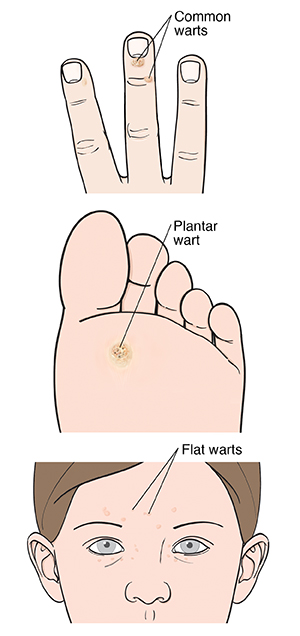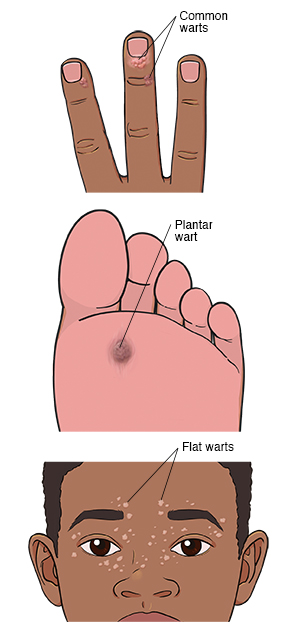What Are Warts?
Warts are common skin growths that can appear anywhere on the body. There are many types of warts. In most cases, they aren't cancer (benign) and are harmless. Warts can be embarrassing or sometimes painful. The good news is that they can be treated.
Who gets warts?
Warts are most common in children and teens. But they can occur at any age. They may be more common in certain jobs, such as those that involve handling raw meat, poultry, or fish. Other risk factors may include:
-
Having a weakened immune system
-
Being exposed to family or classmates with warts
-
Having skin conditions like eczema
What causes warts?
Warts are caused by the human papillomavirus (HPV). There are over 100 different types of HPV. This virus can spread between people. You can be exposed to the virus and not get warts. Warts tend to form where skin is damaged or broken. But they can also appear elsewhere. Left untreated, warts can grow in number. They can also spread to other parts of the body.
Types of warts
 |
| Different types of warts on light skin. |
 |
| Different types of warts on dark skin. |
There are many types of warts. Some of the most common ones are described below:
-
Common warts. These have a raised, rough surface. Enlarged blood vessels in the warts look like dots on the warts’ surface. Common warts form mainly on the hands and knees. But they can appear on other parts of the body.
-
Plantar warts. These are warts on the soles of the feet. When you stand or walk, pressure makes plantar warts painful. When they form in clusters, plantar warts are called mosaic warts.
-
Periungual warts. These form under and around fingernails. People who bite their nails are more at risk.
-
Filiform warts. These are slender, fingerlike growths that can dangle from the skin. They most often appear on the face and neck.
-
Flat warts. These are small, smooth growths. They tend to form in clusters on the face, backs of the hands, or legs.
-
Genital warts. These can appear on or around the genitals. These warts can spread and are linked to cervical, anal, and other cancers. They can be passed to partners during sex. So it's important to have them treated quickly and discuss these with sex partners.
© 2000-2024 The StayWell Company, LLC. All rights reserved. This information is not intended as a substitute for professional medical care. Always follow your healthcare professional's instructions.